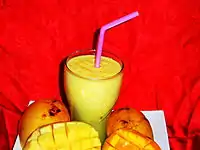
A national drink is a distinct beverage that is strongly associated with a particular country, and can be part of their national identity and self-image. National drinks fall into two categories: alcoholic and non-alcoholic. An alcoholic national drink is sometimes a liquor drunk straight/neat (e.g., vodka in Russia), but is most often a mixed drink (e.g., caipirinhas in Brazil and Singapore Slings in Singapore), beer, or wine. Non-alcoholic national drinks include Coca-Cola in the US, boba tea in Taiwan, Thai iced tea in Thailand, and many others.
A beverage can be considered a national drink for a variety of reasons:
- It is a common drink, made from a selection of locally available foodstuffs that can be prepared in a distinctive way, such as mango lassi that uses dahi, a traditional yogurt or fermented milk product originating from the Indian subcontinent.[1]
- It contains a particular 'exotic' ingredient that is produced locally.
- It is served as a festive culinary tradition that forms part of a cultural heritage.
- It has been promoted as a national drink by the country itself.
In some cases, it may be impossible to settle on a national drink for a particular country. In the realm of food at least, it may be impossible to choose a single national dish, even unofficially, for countries such as Mexico, China, or India because of their diverse ethnic populations and cultures. At the other end of the spectrum, and now referring to drinks, sometimes different countries see the same beverage as their national drink (e.g., pisco sour in Peru and Chile).
The national drinks below are categorized within geo-political regions modified from the United Nations' five "regional groups". This list usually does not include moonshines or alcoholic beverages produced illicitly.[2]
America
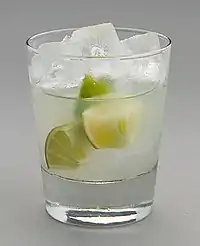
North
.svg.png.webp) Canada: A Caesar is a cocktail that originated in Calgary, and is widely drunk in all parts of Canada. Similar to a Bloody Mary, it contains vodka, a blend of tomato juice, clam broth, hot sauce, and Worcestershire sauce, and is served with ice in a salt-rimmed glass, typically garnished with a stalk of celery and wedge of lime. What distinguishes the two is that only the Caesar contains clam broth. Calgary officially celebrated an anniversary of its creation and launched a national petition for it to be recognized as the official cocktail of Canada.[3]
Canada: A Caesar is a cocktail that originated in Calgary, and is widely drunk in all parts of Canada. Similar to a Bloody Mary, it contains vodka, a blend of tomato juice, clam broth, hot sauce, and Worcestershire sauce, and is served with ice in a salt-rimmed glass, typically garnished with a stalk of celery and wedge of lime. What distinguishes the two is that only the Caesar contains clam broth. Calgary officially celebrated an anniversary of its creation and launched a national petition for it to be recognized as the official cocktail of Canada.[3] United States: Coffee[4] was defiantly adopted as an alternative to British tea in the period leading up to the American Revolution. Coca-Cola[5] is America's iconic soft drink, with the name of the drink referring to two of its original ingredients: coca leaves and kola nuts (a source of caffeine). Bourbon (whiskey),[6] named for Bourbon County, Kentucky, is a corn whiskey aged in charred oak barrels. It was proclaimed the U.S. National Spirit by an act of Congress in 1964.
United States: Coffee[4] was defiantly adopted as an alternative to British tea in the period leading up to the American Revolution. Coca-Cola[5] is America's iconic soft drink, with the name of the drink referring to two of its original ingredients: coca leaves and kola nuts (a source of caffeine). Bourbon (whiskey),[6] named for Bourbon County, Kentucky, is a corn whiskey aged in charred oak barrels. It was proclaimed the U.S. National Spirit by an act of Congress in 1964. Mexico: Tequila is a liquor distilled from the blue agave plant, primarily in the area surrounding the city of Tequila, of the central western Mexican state of Jalisco. In 2018, the Mexican government approved a proposal to celebrate every third Saturday of March as National Tequila Day.[7] Aguas frescas are also quite popular, two notable ones being Jamaica and horchata. A margarita is another notable drink containing tequila.
Mexico: Tequila is a liquor distilled from the blue agave plant, primarily in the area surrounding the city of Tequila, of the central western Mexican state of Jalisco. In 2018, the Mexican government approved a proposal to celebrate every third Saturday of March as National Tequila Day.[7] Aguas frescas are also quite popular, two notable ones being Jamaica and horchata. A margarita is another notable drink containing tequila.
Central and South
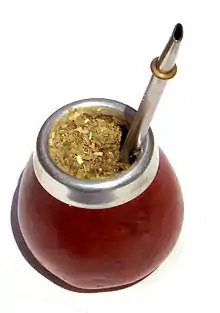
 Antigua and Barbuda: Rum
Antigua and Barbuda: Rum Argentina: Mate. Wine.[8] Fernet con coca is a cocktail that consists in Cola and Fernet on ice. It is usually prepared with Coca-Cola and Fernet Branca. The fernet with cola was created in the city of Córdoba and is an emblem of that province. Hesperidina
Argentina: Mate. Wine.[8] Fernet con coca is a cocktail that consists in Cola and Fernet on ice. It is usually prepared with Coca-Cola and Fernet Branca. The fernet with cola was created in the city of Córdoba and is an emblem of that province. Hesperidina Bahamas: Switcha
Bahamas: Switcha Barbados: Mauby
Barbados: Mauby Belize: Rum Punch
Belize: Rum Punch Bermuda: Rum swizzle,[9][10] Dark N' Stormy (Only classified as such if made with Gosling's Dark Rum only made in Bermuda.)
Bermuda: Rum swizzle,[9][10] Dark N' Stormy (Only classified as such if made with Gosling's Dark Rum only made in Bermuda.).svg.png.webp) Bolivia (Plurinational State of): Chuflay, Singani
Bolivia (Plurinational State of): Chuflay, Singani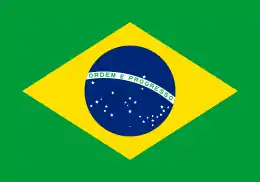 Brazil: Caipirinha is a well-known cocktail made of cachaça, lime, and sugar,[11][12][13] while guaraná is a fruit native to Brazil, common in several drinks, specially soft drinks.
Brazil: Caipirinha is a well-known cocktail made of cachaça, lime, and sugar,[11][12][13] while guaraná is a fruit native to Brazil, common in several drinks, specially soft drinks. Curaçao: Curaçao liqueur is traditionally made with the dried peels of the Laraha, which is a bitter orange native to Curaçao.[14] The liqueur is distilled along with sweet fragrant oils, derived from the dried Laraha peels. Following distillation blue or orange colors are added for an exotic appearance.[15]
Curaçao: Curaçao liqueur is traditionally made with the dried peels of the Laraha, which is a bitter orange native to Curaçao.[14] The liqueur is distilled along with sweet fragrant oils, derived from the dried Laraha peels. Following distillation blue or orange colors are added for an exotic appearance.[15] Chile: Pisco sour, Piscola
Chile: Pisco sour, Piscola Colombia: Aguardiente, coffee
Colombia: Aguardiente, coffee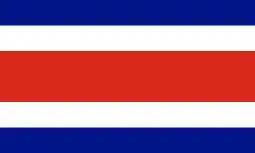 Costa Rica: Imperial, Guaro Cacique.
Costa Rica: Imperial, Guaro Cacique.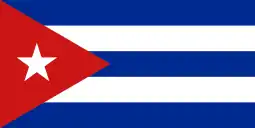 Cuba: Cuba Libre, Mojito, Daiquiri
Cuba: Cuba Libre, Mojito, Daiquiri Dominica: Kubuli, Coconut rum punch
Dominica: Kubuli, Coconut rum punch Dominican Republic: Mama Juana
Dominican Republic: Mama Juana Ecuador: Chicha
Ecuador: Chicha El Salvador: Pilsener, Champagne cola
El Salvador: Pilsener, Champagne cola Grenada: Rum Punch
Grenada: Rum Punch Guatemala: Gallo
Guatemala: Gallo Guyana: Mauby
Guyana: Mauby Haiti: Barbancourt is a rum produced and bottled in Haiti by Société du Rhum Barbancourt, one Haiti's oldest companies. It is made by distillation of sugar cane juice rather than the sugar cane by-product molasses. Fermentation of fresh sugar cane juice is considered to provide a more flavorful product.[16]
Haiti: Barbancourt is a rum produced and bottled in Haiti by Société du Rhum Barbancourt, one Haiti's oldest companies. It is made by distillation of sugar cane juice rather than the sugar cane by-product molasses. Fermentation of fresh sugar cane juice is considered to provide a more flavorful product.[16] Honduras: Pinol
Honduras: Pinol Jamaica: Rum Punch
Jamaica: Rum Punch Nicaragua: Macuá
Nicaragua: Macuá Panama: Seco Herrerano
Panama: Seco Herrerano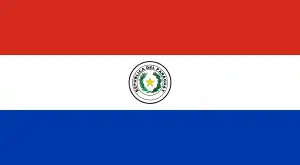 Paraguay: Mate is an infusion that is prepared by soaking dried yerba mate leaves in hot water and served with a metal straw and a hollow calabash. This is served and shared in the round, making it an integral part of society. Its origin is shared with Argentina and Uruguay. Carrulim is an alcoholic beverage made from caña blanca paraguaya, rue, sugar and lemon juice.
Paraguay: Mate is an infusion that is prepared by soaking dried yerba mate leaves in hot water and served with a metal straw and a hollow calabash. This is served and shared in the round, making it an integral part of society. Its origin is shared with Argentina and Uruguay. Carrulim is an alcoholic beverage made from caña blanca paraguaya, rue, sugar and lemon juice. Peru: Pisco sour's[13][12][11] name comes from pisco, which is its base liquor, and the cocktail term sour, in reference to sour citrus juice and sweetener components. The drink originated in the city of Pisco. Inca Kola, a lemon verbena based soda, is also popular.
Peru: Pisco sour's[13][12][11] name comes from pisco, which is its base liquor, and the cocktail term sour, in reference to sour citrus juice and sweetener components. The drink originated in the city of Pisco. Inca Kola, a lemon verbena based soda, is also popular. Puerto Rico (US): Piña colada
Puerto Rico (US): Piña colada Saint Kitts and Nevis: Rum
Saint Kitts and Nevis: Rum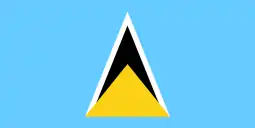 Saint Lucia: Bounty brand Rum
Saint Lucia: Bounty brand Rum Saint Vincent and the Grenadines: Golden Apple Juice
Saint Vincent and the Grenadines: Golden Apple Juice Suriname: Kasiri
Suriname: Kasiri Trinidad and Tobago: Queen's Park Swizzle
Trinidad and Tobago: Queen's Park Swizzle Uruguay: Mate. medio y medio, uvita (a type of fortified wine), grappamiel, amarga (a kind of bitter or amaro made of local herbs), schnaps made from local caña or grappa.
Uruguay: Mate. medio y medio, uvita (a type of fortified wine), grappamiel, amarga (a kind of bitter or amaro made of local herbs), schnaps made from local caña or grappa. Venezuela (Bolivarian Republic of): Rum, tizana
Venezuela (Bolivarian Republic of): Rum, tizana
Europe

The "beer belt" in Europe includes Belgium, Germany, the UK, and Ireland, whereas the "wine belt" includes the Mediterranean countries like Spain, Italy, and Greece. Several drinks are common and particular to Slavic countries. Vodka is a clear alcoholic beverage made most often by distilling the liquid from fermented cereal grains and potatoes. Countries where vodka is identified as a national beverage have been referred to as the "vodka belt". Kvass is a traditional fermented non-alcoholic beverage commonly made from rye bread and is drunk in many Slavic countries, as well as Latvia and Lithuania. Kompot is another drink that is traditionally popular throughout this region and made by boiling together different fruit including strawberries, apricots, peaches, apples, and raisins in large volume of water and served hot or cold, depending on tradition and season. Fruit brandies are popular in the Balkans, while Brännvin and Akvavit are popular in Scandinavia.

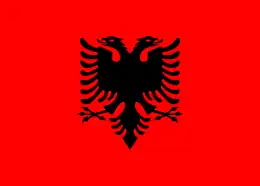 Albania: Raki
Albania: Raki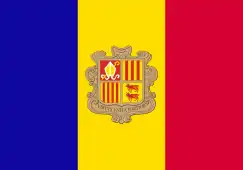 Andorra: Brandy, Wine
Andorra: Brandy, Wine Austria: Almdudler
Austria: Almdudler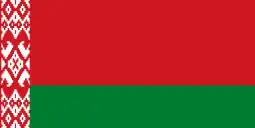 Belarus: Byarozavik is a traditional Belarusian drink made from birch sap, achieving widespread popularity in the Soviet Union before undergoing a modern resurgence.
Belarus: Byarozavik is a traditional Belarusian drink made from birch sap, achieving widespread popularity in the Soviet Union before undergoing a modern resurgence..svg.png.webp) Belgium: Belgium is situated in the “Beer belt” and is known for its beers and breweries. There are over 1,400 kinds of beer and this alcoholic drink is important in Belgian social life. See Belgian beer culture and Beer in Belgium.
Belgium: Belgium is situated in the “Beer belt” and is known for its beers and breweries. There are over 1,400 kinds of beer and this alcoholic drink is important in Belgian social life. See Belgian beer culture and Beer in Belgium. Bosnia and Herzegovina: Rakija, coffee
Bosnia and Herzegovina: Rakija, coffee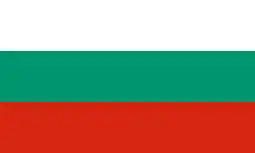 Bulgaria: Bulgaria considers Rakia to be its national beverage, as well as the place of origin of this distilled beverage that can be made from fruits like plums and apricots.[17]
Bulgaria: Bulgaria considers Rakia to be its national beverage, as well as the place of origin of this distilled beverage that can be made from fruits like plums and apricots.[17]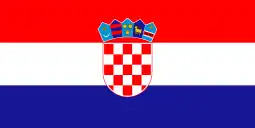 Croatia: Rakija, Pelinkovac, Cedevita
Croatia: Rakija, Pelinkovac, Cedevita Cyprus: Zivania, Brandy sour (unofficial)
Cyprus: Zivania, Brandy sour (unofficial) Czech Republic: Kofola,[18] Pilsner is a pale lager originating in Plzeň.
Czech Republic: Kofola,[18] Pilsner is a pale lager originating in Plzeň. Denmark: Akavit, Brännvin, Snaps, Gammel Dansk[19]
Denmark: Akavit, Brännvin, Snaps, Gammel Dansk[19] Estonia: Viru Valge, koduõlu (homebrew beer), kama
Estonia: Viru Valge, koduõlu (homebrew beer), kama Finland: Lonkero[20]
Finland: Lonkero[20] France: Red wine is a type of wine made from dark-colored (black) grape varieties.[21][22] Champagne is a well known white wine from France.
France: Red wine is a type of wine made from dark-colored (black) grape varieties.[21][22] Champagne is a well known white wine from France. Germany: Lager,[22][21] Fanta,[23] Spezi[24]
Germany: Lager,[22][21] Fanta,[23] Spezi[24] Georgia: Chacha and Red wine
Georgia: Chacha and Red wine Greece: Ouzo is a dry anise-flavoured aperitif that is widely consumed in Greece and Cyprus.[25][21][22]
Greece: Ouzo is a dry anise-flavoured aperitif that is widely consumed in Greece and Cyprus.[25][21][22] Hungary: Pálinka
Hungary: Pálinka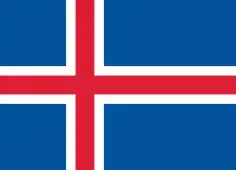 Iceland: Brennivín, Appelsín
Iceland: Brennivín, Appelsín Ireland: Guinness is a dark Irish dry stout.[26][27] Irish whiskey is also popular.
Ireland: Guinness is a dark Irish dry stout.[26][27] Irish whiskey is also popular. Italy: Chinotto is a type of carbonated soft drink produced from the juice of the fruit of the myrtle-leaved orange tree (Citrus myrtifolia); Wine; Spritz; Grappa; Espresso; Cappuccino
Italy: Chinotto is a type of carbonated soft drink produced from the juice of the fruit of the myrtle-leaved orange tree (Citrus myrtifolia); Wine; Spritz; Grappa; Espresso; Cappuccino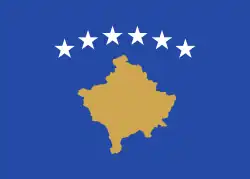 Kosovo: Rakia and Semoj, fermented cabbage juice
Kosovo: Rakia and Semoj, fermented cabbage juice Latvia: Riga Black Balsam[28]
Latvia: Riga Black Balsam[28] Liechtenstein: Blauburgunder
Liechtenstein: Blauburgunder Lithuania: Midus, Gira
Lithuania: Midus, Gira Luxembourg: Crémant de Luxembourg
Luxembourg: Crémant de Luxembourg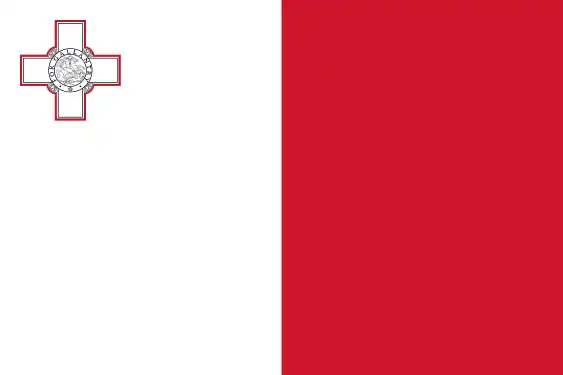 Malta: Kinnie,[29] Bajtra liqueur (unofficial), cactus pear liquor, Maltese falcon
Malta: Kinnie,[29] Bajtra liqueur (unofficial), cactus pear liquor, Maltese falcon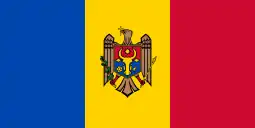 Moldova: Divin (Distilled Wine, portmanteau of Distilat de Vin)
Moldova: Divin (Distilled Wine, portmanteau of Distilat de Vin) Monaco: Champagne
Monaco: Champagne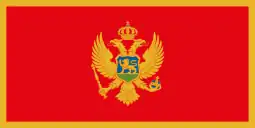 Montenegro: Rakija
Montenegro: Rakija Netherlands: Jenever
Netherlands: Jenever North Macedonia: Rakija, Boza
North Macedonia: Rakija, Boza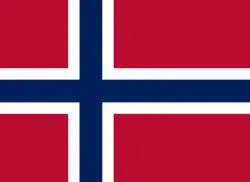 Norway: Akvavit, Solo
Norway: Akvavit, Solo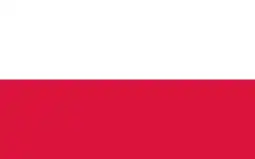 Poland: Vodka is regarded a national beverage as some sources consider it to have originated in Poland, dating back to 15th century.[30] Other distinctive alcoholic drinks feature bison grass vodka, krupnik, variety of traditional tinctures (nalewka) like piołunówka, along with traditional Polish meads.
Poland: Vodka is regarded a national beverage as some sources consider it to have originated in Poland, dating back to 15th century.[30] Other distinctive alcoholic drinks feature bison grass vodka, krupnik, variety of traditional tinctures (nalewka) like piołunówka, along with traditional Polish meads. Portugal: Port wine is a sweet Portuguese fortified wine produced with distilled grape spirits in the Douro Valley in the northern provinces of Portugal and is commonly served as a dessert wine.[31] There are also distinct sorts of non port portuguese wines produced in particular regions.[32]
Portugal: Port wine is a sweet Portuguese fortified wine produced with distilled grape spirits in the Douro Valley in the northern provinces of Portugal and is commonly served as a dessert wine.[31] There are also distinct sorts of non port portuguese wines produced in particular regions.[32]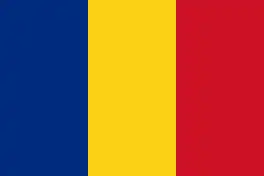 Romania: Țuică, sometimes referred to as "white lightning" due to its clarity and potency, is a plum fruit brandy, that is distilled in a brass still, using traditional fire sources such as wood and charcoal. Țuică is traditionally drunk prior to meals and at celebrations.[33]
Romania: Țuică, sometimes referred to as "white lightning" due to its clarity and potency, is a plum fruit brandy, that is distilled in a brass still, using traditional fire sources such as wood and charcoal. Țuică is traditionally drunk prior to meals and at celebrations.[33] Russia: Kvass is a traditional fermented non-alcoholic beverage commonly made from rye bread, and while kvass is seen as the national non-alcoholic drink, it is vodka that most Russians identify as their national alcoholic beverage.[34]
Russia: Kvass is a traditional fermented non-alcoholic beverage commonly made from rye bread, and while kvass is seen as the national non-alcoholic drink, it is vodka that most Russians identify as their national alcoholic beverage.[34] San Marino: Biancale
San Marino: Biancale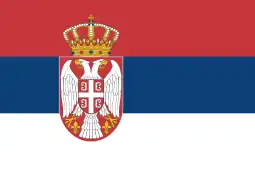 Serbia: Rakija.
Serbia: Rakija.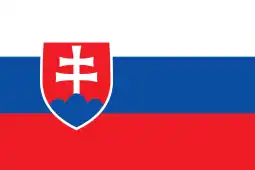 Slovakia: Borovička is a juniper alcoholic spirit.
Slovakia: Borovička is a juniper alcoholic spirit.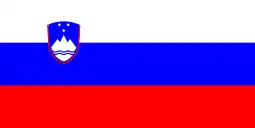 Slovenia: Schnapps
Slovenia: Schnapps Spain: A punch, sangria traditionally consists of red wine and chopped fruit, often with other ingredients such as orange juice or brandy.[12][13]
Spain: A punch, sangria traditionally consists of red wine and chopped fruit, often with other ingredients such as orange juice or brandy.[12][13] Sweden: Brännvin, Punsch,[35] Akvavit, Julmust, Pommac, Champis
Sweden: Brännvin, Punsch,[35] Akvavit, Julmust, Pommac, Champis.svg.png.webp) Switzerland: Rivella.
Switzerland: Rivella.
 Ukraine: Horilka, Kvass
Ukraine: Horilka, Kvass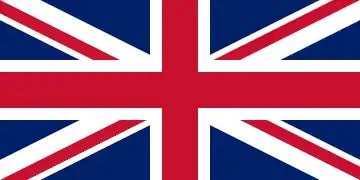 United Kingdom: Tea
United Kingdom: Tea
 England: Gin[36]
England: Gin[36] Scotland Scotch is a whisky that is by law required to be both produced in Scotland and aged in oak barrels for at least three years.[37] Irn-Bru (pronounced "Iron Brew") is a sweet, fruity flavoured, soda with a rusty orange color that has been referred to as the country's "other national drink."[38]
Scotland Scotch is a whisky that is by law required to be both produced in Scotland and aged in oak barrels for at least three years.[37] Irn-Bru (pronounced "Iron Brew") is a sweet, fruity flavoured, soda with a rusty orange color that has been referred to as the country's "other national drink."[38] Wales: Perry[39]
Wales: Perry[39]
Africa
 Algeria: Coffee, Tea
Algeria: Coffee, Tea Angola: Cuca Beer
Angola: Cuca Beer Benin: Sodabi
Benin: Sodabi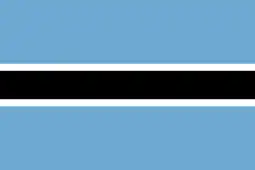 Botswana: Chibuku Shake Shake is a traditional beer that originated in Botswana, and now other African countries manufacture it. Keone Mooka Mageu is a traditional fermented porridge, but it is drunk. Ginger beer is a favorite non-alcoholic homemade drink which is served at special occasions, like weddings and parties.
Botswana: Chibuku Shake Shake is a traditional beer that originated in Botswana, and now other African countries manufacture it. Keone Mooka Mageu is a traditional fermented porridge, but it is drunk. Ginger beer is a favorite non-alcoholic homemade drink which is served at special occasions, like weddings and parties.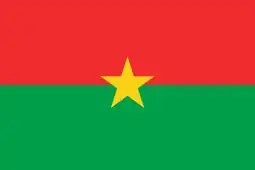 Burkina Faso: Zoomkoom
Burkina Faso: Zoomkoom Burundi: Sorghum beer
Burundi: Sorghum beer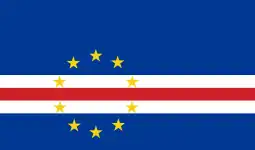 Cabo Verde: Grogue
Cabo Verde: Grogue Cameroon: Odontol
Cameroon: Odontol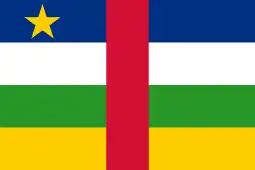 Central African Republic: Karkanji, Coffee
Central African Republic: Karkanji, Coffee Chad: Jus de Fruit, Tea
Chad: Jus de Fruit, Tea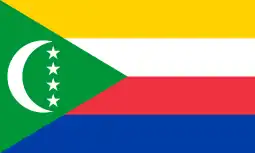 Comoros: Singani
Comoros: Singani Congo: Lotoko
Congo: Lotoko Côte d'Ivoire: Akpeteshie
Côte d'Ivoire: Akpeteshie Democratic Republic of the Congo: Lotoko
Democratic Republic of the Congo: Lotoko Djibouti: Kabisa (Djiboutian energy drink, there is no national or popular drink in Djibouti due to strict laws from the government.)
Djibouti: Kabisa (Djiboutian energy drink, there is no national or popular drink in Djibouti due to strict laws from the government.)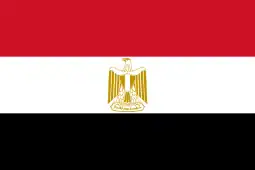 Egypt: Black tea, Sugarcane juice
Egypt: Black tea, Sugarcane juice Equatorial Guinea: Malamba Juice
Equatorial Guinea: Malamba Juice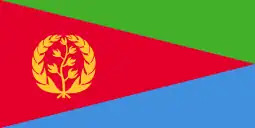 Eritrea: Siwa, coffee, araki, tea [40]
Eritrea: Siwa, coffee, araki, tea [40]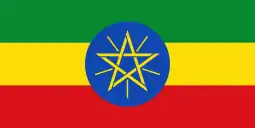 Ethiopia: Coffee, Tej[11][41][42]
Ethiopia: Coffee, Tej[11][41][42] Eswatini: Sibebe
Eswatini: Sibebe Gabon: Regab
Gabon: Regab Gambia (Republic of The): Ginger Beer
Gambia (Republic of The): Ginger Beer Ghana: Akpeteshie (National spirit)
Ghana: Akpeteshie (National spirit) Guinea: Malamba Juice
Guinea: Malamba Juice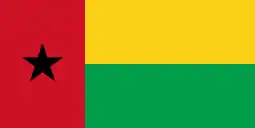 Guinea-Bissau: Cana de Cajeu
Guinea-Bissau: Cana de Cajeu Kenya: Tea, Dawa cocktail
Kenya: Tea, Dawa cocktail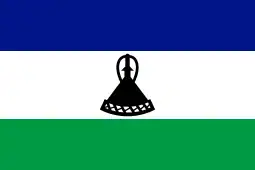 Lesotho: Tholoana
Lesotho: Tholoana Liberia: Ginger beer
Liberia: Ginger beer Libya: Libyan tea, Arabic coffee
Libya: Libyan tea, Arabic coffee Madagascar: Rum
Madagascar: Rum Malawi: Thobwa
Malawi: Thobwa Mali: Green tea
Mali: Green tea Mauritania: Tea, Zrig (camel milk)
Mauritania: Tea, Zrig (camel milk) Mauritius: Alouda
Mauritius: Alouda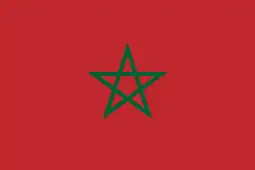 Morocco: Moroccan mint tea (atai)[43][44] is a green tea prepared with spearmint leaves and sugar.
Morocco: Moroccan mint tea (atai)[43][44] is a green tea prepared with spearmint leaves and sugar.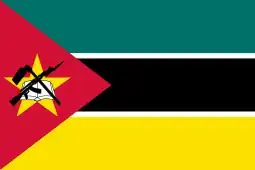 Mozambique: Tipo Tinto
Mozambique: Tipo Tinto Namibia: Oshikundu, Beer (Either brewed domestically or from Germany.)
Namibia: Oshikundu, Beer (Either brewed domestically or from Germany.) Niger: Biere Niger
Niger: Biere Niger Nigeria: Akpeteshie
Nigeria: Akpeteshie Rwanda: Ikigage, sorghum beer
Rwanda: Ikigage, sorghum beer São Tomé and Príncipe: Palm Wine
São Tomé and Príncipe: Palm Wine Senegal: Bissap
Senegal: Bissap Seychelles: Buka
Seychelles: Buka Sierra Leone: Poyo
Sierra Leone: Poyo Somalia: No official drink, however Shah hawaash (Cardamom tea), coffee, and camel milk are popular
Somalia: No official drink, however Shah hawaash (Cardamom tea), coffee, and camel milk are popular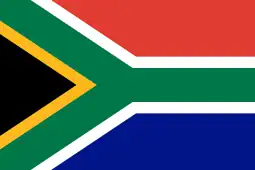 South Africa: No official drink but Beer, Springbokkie and Boeber are common. Umqombothi a traditional Nguni sorghum beer is a popular drink to celebrate special ceremonies, and more recently rooibos or “bush” tea is referred to as the unofficial national drink.
South Africa: No official drink but Beer, Springbokkie and Boeber are common. Umqombothi a traditional Nguni sorghum beer is a popular drink to celebrate special ceremonies, and more recently rooibos or “bush” tea is referred to as the unofficial national drink. South Sudan: Araqi
South Sudan: Araqi Sudan: No official drink, however Roselle tea, Araqi, Gongolez (baobab drink), Hulu-Murr (spiced sorghum beverage)[45] and Aradaib (tamarind) are popular
Sudan: No official drink, however Roselle tea, Araqi, Gongolez (baobab drink), Hulu-Murr (spiced sorghum beverage)[45] and Aradaib (tamarind) are popular Togo: Tchakpallo
Togo: Tchakpallo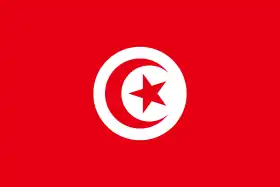 Tunisia: Tea[46]
Tunisia: Tea[46] Uganda: Waragi
Uganda: Waragi United Republic of Tanzania: Konyagi, tea, coffee[47]
United Republic of Tanzania: Konyagi, tea, coffee[47] Zambia: Munkoyo
Zambia: Munkoyo Zimbabwe: Chibuku[11][41]
Zimbabwe: Chibuku[11][41]
Asia
East

 China: Tea has been a vital part of the Chinese culture for thousands of years, and the country is considered to have the earliest records of tea consumption, with possible records dating back to the 10th century BC.[48][49] Depending on different traditional methods in processing the tea leaves, Chinese tea can be classified into at least six distinct categories: white tea, yellow tea, green tea, oolong tea, black tea and post-fermented tea (dark tea).
China: Tea has been a vital part of the Chinese culture for thousands of years, and the country is considered to have the earliest records of tea consumption, with possible records dating back to the 10th century BC.[48][49] Depending on different traditional methods in processing the tea leaves, Chinese tea can be classified into at least six distinct categories: white tea, yellow tea, green tea, oolong tea, black tea and post-fermented tea (dark tea).
- The Chinese national liquor, Baijiu (Chinese: 白酒; pinyin: báijiǔ; lit. 'white (clear) liquor') is a distilled alcoholic beverage made from various types of grains, including rice, glutinous rice, wheat, barley, and millet.[50][51] Baijiu was first made 5,000 years ago. Baijiu can be broken down into five main aroma categories: strong, light, sauce (soy, specifically), rice, and mixed.
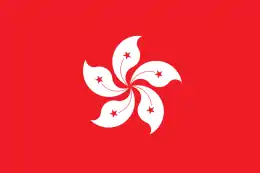 Hong Kong: Hong Kong-style milk tea, whose unique tea making technique is listed as an "Intangible Cultural Heritage" by the United Nations[52]
Hong Kong: Hong Kong-style milk tea, whose unique tea making technique is listed as an "Intangible Cultural Heritage" by the United Nations[52] Macau: Coffee (typically served with condensed milk) and tea[53]
Macau: Coffee (typically served with condensed milk) and tea[53] Japan: Green Tea.[54] Tea consumption became popular among the gentry during the 12th century, after the publication of Eisai's Kissa Yōjōki. Uji, with its strategic location near the capital at Kyoto, became Japan's first major tea-producing region during this period. Beginning in the 13th and 14th centuries, Japanese tea culture developed the distinctive features for which it is known today, and the Japanese tea ceremony emerged as a key component of that culture.
Japan: Green Tea.[54] Tea consumption became popular among the gentry during the 12th century, after the publication of Eisai's Kissa Yōjōki. Uji, with its strategic location near the capital at Kyoto, became Japan's first major tea-producing region during this period. Beginning in the 13th and 14th centuries, Japanese tea culture developed the distinctive features for which it is known today, and the Japanese tea ceremony emerged as a key component of that culture.
- Sake, also referred to as Japanese rice wine, is an alcoholic beverage made by fermenting rice that has been polished to remove the bran.[11][12][13]
 Mongolia: Airag (Mongolian: айраг [ˈai̯rəɡ])[55] or, in some areas, tsegee is a fermented dairy product traditionally made from mare's milk. The drink remains important to the peoples of the Central Asian steppes, of Huno-Bulgar, Turkic and Mongol origin: Kazakhs, Bashkirs, Kalmyks, Kyrgyz, Mongols, and Yakuts.[56][57] A 1982 source reported 230,000 horses were kept in the Soviet Union specifically for producing milk to make into kumis.[58] Rinchingiin Indra, writing about Mongolian dairying, says "it takes considerable skill to milk a mare" and describes the technique: the milker kneels on one knee, with a pail propped on the other, steadied by a string tied to an arm. One arm is wrapped behind the mare's rear leg and the other in front. A foal starts the milk flow and is pulled away by another person, but left touching the mare's side during the entire process.[59] In Mongolia, the milking season for horses traditionally runs between mid-June and early October. During one season, a mare produces approximately 1,000 to 1,200 litres of milk, of which about half is left to the foals.[60]
Mongolia: Airag (Mongolian: айраг [ˈai̯rəɡ])[55] or, in some areas, tsegee is a fermented dairy product traditionally made from mare's milk. The drink remains important to the peoples of the Central Asian steppes, of Huno-Bulgar, Turkic and Mongol origin: Kazakhs, Bashkirs, Kalmyks, Kyrgyz, Mongols, and Yakuts.[56][57] A 1982 source reported 230,000 horses were kept in the Soviet Union specifically for producing milk to make into kumis.[58] Rinchingiin Indra, writing about Mongolian dairying, says "it takes considerable skill to milk a mare" and describes the technique: the milker kneels on one knee, with a pail propped on the other, steadied by a string tied to an arm. One arm is wrapped behind the mare's rear leg and the other in front. A foal starts the milk flow and is pulled away by another person, but left touching the mare's side during the entire process.[59] In Mongolia, the milking season for horses traditionally runs between mid-June and early October. During one season, a mare produces approximately 1,000 to 1,200 litres of milk, of which about half is left to the foals.[60]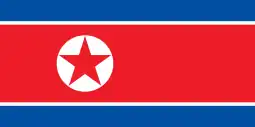 North Korea: On June 18, 2019, Kim Jong-un designated Pyongyang Soju, an alcoholic beverage that embodies the "innocent and tender hearts" of the North Korean people as the national beverage of North Korea, according to a state propaganda service.[61] Soju is a clear, colorless distilled beverage of Korean origin.[62]
North Korea: On June 18, 2019, Kim Jong-un designated Pyongyang Soju, an alcoholic beverage that embodies the "innocent and tender hearts" of the North Korean people as the national beverage of North Korea, according to a state propaganda service.[61] Soju is a clear, colorless distilled beverage of Korean origin.[62] South Korea: Soju (/ˈsoʊdʒuː/; from Korean: 소주; 燒酒 [so.dʑu]) is a clear, colorless distilled beverage of Korean origin.[63][64][65] It is usually consumed neat, and its alcohol content varies from about 16.8% to 53% alcohol by volume (ABV).[66][67] Most brands of soju are made in South Korea. While soju is traditionally made from rice, wheat, or barley, modern producers often replace rice with other starches such as potatoes, sweet potatoes, or tapioca.[68]
South Korea: Soju (/ˈsoʊdʒuː/; from Korean: 소주; 燒酒 [so.dʑu]) is a clear, colorless distilled beverage of Korean origin.[63][64][65] It is usually consumed neat, and its alcohol content varies from about 16.8% to 53% alcohol by volume (ABV).[66][67] Most brands of soju are made in South Korea. While soju is traditionally made from rice, wheat, or barley, modern producers often replace rice with other starches such as potatoes, sweet potatoes, or tapioca.[68]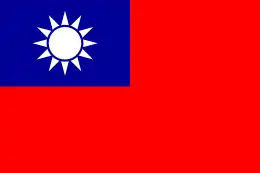 Taiwan: Bubble tea[69][70] (also known as pearl milk tea, bubble milk tea, or boba) is a Taiwanese tea-based drink invented in the 1980s.[71]
Taiwan: Bubble tea[69][70] (also known as pearl milk tea, bubble milk tea, or boba) is a Taiwanese tea-based drink invented in the 1980s.[71]
Southeast

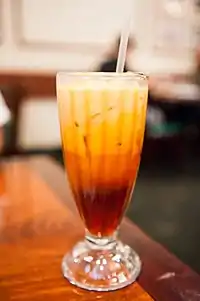
 Brunei: No national drink, however Air Batu Campur (ABC) is popular among citizens.
Brunei: No national drink, however Air Batu Campur (ABC) is popular among citizens.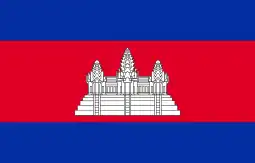 Cambodia: Sombai infused rice wine.[72][73]
Cambodia: Sombai infused rice wine.[72][73] Indonesia: Es teler, a sweet iced concoction created by Murniati Widjaja, who won a competition to come up with a national drink for Indonesia in 1982.[74][75]
Indonesia: Es teler, a sweet iced concoction created by Murniati Widjaja, who won a competition to come up with a national drink for Indonesia in 1982.[74][75] Laos: Lao-Lao (Lao: ເຫລົ້າລາວ) is a Laotian rice whisky produced in Laos.[76][77] Along with Beerlao, lao-Lao is a staple drink in Laos. The name lao-Lao is not the same word repeated twice, but two different words pronounced with different tones: the first, ເຫລົ້າ, means "alcohol" and is pronounced with a low-falling tone in the standard dialect, while the second, ລາວ, means Laotian ("Lao") and is pronounced with a high(-rising) tone.
Laos: Lao-Lao (Lao: ເຫລົ້າລາວ) is a Laotian rice whisky produced in Laos.[76][77] Along with Beerlao, lao-Lao is a staple drink in Laos. The name lao-Lao is not the same word repeated twice, but two different words pronounced with different tones: the first, ເຫລົ້າ, means "alcohol" and is pronounced with a low-falling tone in the standard dialect, while the second, ລາວ, means Laotian ("Lao") and is pronounced with a high(-rising) tone.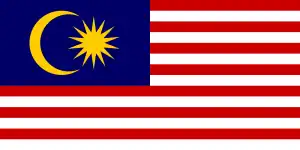 Malaysia: Teh tarik (literally "pulled tea") is a hot milk tea beverage which can be commonly found in restaurants, outdoor stalls and kopi tiams.[78] Its name is derived from the pouring process of "pulling" the drink during preparation. It is made from a strong brew of black tea blended with condensed milk. It is the national drink of Malaysia.[79]
Malaysia: Teh tarik (literally "pulled tea") is a hot milk tea beverage which can be commonly found in restaurants, outdoor stalls and kopi tiams.[78] Its name is derived from the pouring process of "pulling" the drink during preparation. It is made from a strong brew of black tea blended with condensed milk. It is the national drink of Malaysia.[79] Myanmar: Lahpet yay is brewed from a mix of fermented or pickled tea, sweetened condensed milk, and evaporated milk. It is traditionally served hot in Burmese tea houses - open air, bustling, street corner places.[80][81]
Myanmar: Lahpet yay is brewed from a mix of fermented or pickled tea, sweetened condensed milk, and evaporated milk. It is traditionally served hot in Burmese tea houses - open air, bustling, street corner places.[80][81] Philippines: Beer (San Miguel Beer).[82]
Philippines: Beer (San Miguel Beer).[82]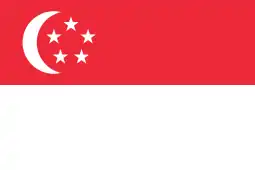 Singapore: Kopi is a type of traditional highly caffeinated black coffee, sometimes served with milk and/or sugar. This drink has Hainanese roots, many of which migrated south to Singapore during the 19th to 20th centuries. It is also otherwise known as Nanyang coffee. Nanyang means ‘South Sea’ in Mandarin, and usually references to Southeast Asia.[83] The Singapore coffee is recognized to be culturally significant[84] and part of the everyday diet and lifestyle of many Singaporeans.[85]
Singapore: Kopi is a type of traditional highly caffeinated black coffee, sometimes served with milk and/or sugar. This drink has Hainanese roots, many of which migrated south to Singapore during the 19th to 20th centuries. It is also otherwise known as Nanyang coffee. Nanyang means ‘South Sea’ in Mandarin, and usually references to Southeast Asia.[83] The Singapore coffee is recognized to be culturally significant[84] and part of the everyday diet and lifestyle of many Singaporeans.[85]- The Singapore Sling is a gin-based sling cocktail from Singapore. It was created before 1915 by Ngiam Tong Boon (Chinese: 严崇文; pinyin: Yán Chóng-Wén), also of Hainanese descent, at the Long Bar in Raffles Hotel, Singapore, and is considered the national cocktail.
- Tiger Beer is considered the national beer of Singapore.
- The Milo dinosaur is a Singaporean chocolate malt–based beverage composed of a cup of iced Milo with undissolved Milo powder added on top of it. It is usually served cold to prevent the powder from immediately dissolving in the drink.[86] It originates from Indian Singaporean eateries in Singapore during the 1990s, and it is now most commonly found in mamak stalls, kopitiams and hawker centres from all ethnic groups in Singapore.[86][87]
 Thailand: Thai tea is a Thai drink made from tea, milk and sugar, and served hot or cold. It is popular in Southeast Asia and is served in many restaurants that serve Thai food.[88] When served cold it is known as Thai iced tea. Another highly popular drink is Krating Daeng, an energy drink which was first introduced in 1976. In Thai, daeng means red, and a krating is a large species of wild bovine native to South Asia. Krating Daeng inspired the creation of the Western drink Red Bull.
Thailand: Thai tea is a Thai drink made from tea, milk and sugar, and served hot or cold. It is popular in Southeast Asia and is served in many restaurants that serve Thai food.[88] When served cold it is known as Thai iced tea. Another highly popular drink is Krating Daeng, an energy drink which was first introduced in 1976. In Thai, daeng means red, and a krating is a large species of wild bovine native to South Asia. Krating Daeng inspired the creation of the Western drink Red Bull.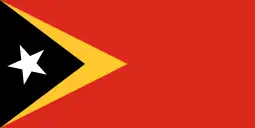 Timor-Leste: Cachaca
Timor-Leste: Cachaca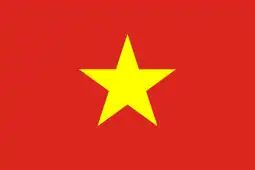 Vietnam: Rượu nếp, Vietnamese rice wine, made from glutinous rice that has been fermented with the aid of yeast and steamed in a banana leaf.
Vietnam: Rượu nếp, Vietnamese rice wine, made from glutinous rice that has been fermented with the aid of yeast and steamed in a banana leaf.
South

 Bangladesh: Tea (Bengali: চা, romanized: Cha) is considered to be the national drink of Bangladesh, with government bodies such as the Bangladesh Tea Board and the Bangladesh Tea Research Institute supporting the production, certification, and exportation of the tea trade in the country.[89] Recently, new types of tea, such as the seven color tea or seven-layer tea, (Bengali: সাত রং চা, romanized: Shat Rong Cha) has popped up as a well-known beverage of the country's Sylhet Division.[90][91] Romesh Ram Gour invented the seven-layer tea after discovering that different tea leaves have different densities.[92][91] Each layer contrasts in color and taste, ranging from syrupy sweet to spicy clove. The result is an alternating dark/light band pattern throughout the drink, giving the tea its name.
Bangladesh: Tea (Bengali: চা, romanized: Cha) is considered to be the national drink of Bangladesh, with government bodies such as the Bangladesh Tea Board and the Bangladesh Tea Research Institute supporting the production, certification, and exportation of the tea trade in the country.[89] Recently, new types of tea, such as the seven color tea or seven-layer tea, (Bengali: সাত রং চা, romanized: Shat Rong Cha) has popped up as a well-known beverage of the country's Sylhet Division.[90][91] Romesh Ram Gour invented the seven-layer tea after discovering that different tea leaves have different densities.[92][91] Each layer contrasts in color and taste, ranging from syrupy sweet to spicy clove. The result is an alternating dark/light band pattern throughout the drink, giving the tea its name. Bhutan: Ara, or Arag, (Tibetan and Dzongkha: ཨ་རག་; Wylie: a-rag; "alcohol, liquor") is a traditional alcoholic beverage consumed in Bhutan. Ara is made from native and high-altitude tolerant barley, rice, maize, millet, or wheat, and may be either fermented or distilled. The beverage is usually a clear, creamy, or white color.[93]
Bhutan: Ara, or Arag, (Tibetan and Dzongkha: ཨ་རག་; Wylie: a-rag; "alcohol, liquor") is a traditional alcoholic beverage consumed in Bhutan. Ara is made from native and high-altitude tolerant barley, rice, maize, millet, or wheat, and may be either fermented or distilled. The beverage is usually a clear, creamy, or white color.[93]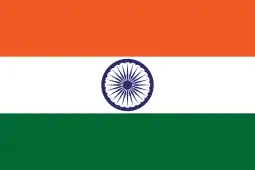 India: Tea is the most widely consumed beverage in India. Lassi or Chaas is another yogurt-based drink and can be sweet or salty. Lassi or Chaas is a blend of yogurt, water, spices and sometimes fruit like mango.[94][95] While the Masala chai is a hot, sweet tea popular throughout the subcontinent and is a combination of brewed black tea, aromatic spices, and herbs, milk and sugar.[96] In southern India, the iconic beverage is Kaapi, also known as Indian filter coffee, which is made by mixing frothed and boiled milk with coffee brewed through a metal filter.[97]
India: Tea is the most widely consumed beverage in India. Lassi or Chaas is another yogurt-based drink and can be sweet or salty. Lassi or Chaas is a blend of yogurt, water, spices and sometimes fruit like mango.[94][95] While the Masala chai is a hot, sweet tea popular throughout the subcontinent and is a combination of brewed black tea, aromatic spices, and herbs, milk and sugar.[96] In southern India, the iconic beverage is Kaapi, also known as Indian filter coffee, which is made by mixing frothed and boiled milk with coffee brewed through a metal filter.[97] Maldives: It can be said that the Maldives have two national drinks. Firstly, due to their history and location near the Indian Subcontinent, sai (tea) is a Maldivian favorite. Secondly, as the Maldives are truly an Island nation, raa (toddy tapped from palm trees) is also has its place in the national identity of the Maldives. Sometimes raa is left to ferment and is thus slightly alcoholic – the closest any Maldivian gets to alcohol.
Maldives: It can be said that the Maldives have two national drinks. Firstly, due to their history and location near the Indian Subcontinent, sai (tea) is a Maldivian favorite. Secondly, as the Maldives are truly an Island nation, raa (toddy tapped from palm trees) is also has its place in the national identity of the Maldives. Sometimes raa is left to ferment and is thus slightly alcoholic – the closest any Maldivian gets to alcohol.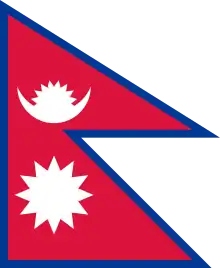 Nepal: Raksi[98] is a strong drink, clear like vodka or gin, tasting somewhat like Japanese sake. It is usually made from kodo millet (kodo) or rice; different grains produce different flavors.[99] The Limbus, for whom it is a traditional beverage,[100] drink an enormous amount of Tongba and raksi served with pieces of pork, water buffalo or goat meat sekuwa.[101] For the Newars, aylaa is indispensable during festivals and various religious rituals as libation, prasad or sagan.
Nepal: Raksi[98] is a strong drink, clear like vodka or gin, tasting somewhat like Japanese sake. It is usually made from kodo millet (kodo) or rice; different grains produce different flavors.[99] The Limbus, for whom it is a traditional beverage,[100] drink an enormous amount of Tongba and raksi served with pieces of pork, water buffalo or goat meat sekuwa.[101] For the Newars, aylaa is indispensable during festivals and various religious rituals as libation, prasad or sagan. Pakistan: Sugarcane juice[102]
Pakistan: Sugarcane juice[102]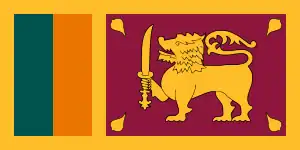 Sri Lanka: Tea
Sri Lanka: Tea
Central
 Afghanistan: Technically there isn't an official beverage, however, tea and doogh are popular
Afghanistan: Technically there isn't an official beverage, however, tea and doogh are popular Kazakhstan: Kumis, fermented horse milk
Kazakhstan: Kumis, fermented horse milk.svg.png.webp) Kyrgyzstan: maksym[103] or jarma, both of which are made out of barley
Kyrgyzstan: maksym[103] or jarma, both of which are made out of barley Tajikistan: Green tea
Tajikistan: Green tea Turkmenistan: Chal
Turkmenistan: Chal Uzbekistan: Green tea
Uzbekistan: Green tea
West
 Armenia: Oghi, Armenian wine, Ararat
Armenia: Oghi, Armenian wine, Ararat Azerbaijan: Black tea, ayran
Azerbaijan: Black tea, ayran Bahrain: Coffee
Bahrain: Coffee Georgia: Chacha and red wine
Georgia: Chacha and red wine Iraq: Coffee, arak, and mint tea
Iraq: Coffee, arak, and mint tea Iran: Doogh, Persian yogurt drink and black tea, Aragh Sagi (underground)
Iran: Doogh, Persian yogurt drink and black tea, Aragh Sagi (underground) Israel: Wine
Israel: Wine Jordan: Arabic coffee, non-sweetened and in small shots, mint lemonade, and arak
Jordan: Arabic coffee, non-sweetened and in small shots, mint lemonade, and arak Kuwait: Arabic coffee (kahwah)
Kuwait: Arabic coffee (kahwah) Lebanon: Arak
Lebanon: Arak Oman: Arabic coffee
Oman: Arabic coffee Palestine: Coffee, arak, mint lemonade
Palestine: Coffee, arak, mint lemonade Qatar: Arabic coffee
Qatar: Arabic coffee Saudi Arabia: Arabic coffee
Saudi Arabia: Arabic coffee Syria: Coffee and arak
Syria: Coffee and arak Turkey: Raki;[104][105] Türk Kahvesi; tea; ayran (as proclaimed by Prime Minister Tayyip Erdogan in 2013) is a non-alcoholic yogurt drink[106][107]
Turkey: Raki;[104][105] Türk Kahvesi; tea; ayran (as proclaimed by Prime Minister Tayyip Erdogan in 2013) is a non-alcoholic yogurt drink[106][107]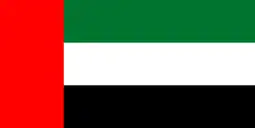 United Arab Emirates: Arabic coffee
United Arab Emirates: Arabic coffee Yemen: Arabic coffee, being one of the oldest known places to grow coffee, Qishr, and Naqe'e Al Zabib
Yemen: Arabic coffee, being one of the oldest known places to grow coffee, Qishr, and Naqe'e Al Zabib
Oceania
 American Samoa (US): Kava
American Samoa (US): Kava.svg.png.webp) Australia: Australia has quickly become the premier country in the world for coffee, thanks to the immigration of Italian and Greek migrants after World War II. Coffee has become a dominating factor in Australian culture. An ABC News article published in 2018 described lemon, lime, and bitters (LLB) as "Australia's national drink".[108] Lemon, lime, and bitters is a mixed drink made with (clear) lemonade, lime cordial, and Angostura bitters. The lemonade is sometimes substituted with soda water[108] or lemon squash. It was served as a non-alcoholic alternative to "Pink Gin" (gin mixed with Angostura bitters).[108] It is often considered to be a non-alcoholic cocktail (or mocktail) due to its exceedingly low alcohol content, though some establishments consider it to be alcoholic and will not serve it without identification or proof of age. Beer and wine have also been referred to as the unofficial national drinks of Australia.
Australia: Australia has quickly become the premier country in the world for coffee, thanks to the immigration of Italian and Greek migrants after World War II. Coffee has become a dominating factor in Australian culture. An ABC News article published in 2018 described lemon, lime, and bitters (LLB) as "Australia's national drink".[108] Lemon, lime, and bitters is a mixed drink made with (clear) lemonade, lime cordial, and Angostura bitters. The lemonade is sometimes substituted with soda water[108] or lemon squash. It was served as a non-alcoholic alternative to "Pink Gin" (gin mixed with Angostura bitters).[108] It is often considered to be a non-alcoholic cocktail (or mocktail) due to its exceedingly low alcohol content, though some establishments consider it to be alcoholic and will not serve it without identification or proof of age. Beer and wine have also been referred to as the unofficial national drinks of Australia. Christmas Island (AU): Coffee
Christmas Island (AU): Coffee_Islands.svg.png.webp) Cocos (Keeling) Islands (AU): Tea
Cocos (Keeling) Islands (AU): Tea Cook Islands: Tumunu
Cook Islands: Tumunu Easter Island: Easter Island Cocktail
Easter Island: Easter Island Cocktail Fiji: Most Fijians would say that Kava is the unofficial national drink of Fiji. Kava (also called "grog" or "yaqona") is drunk at all times of day in both public and private settings. The consumption of the drink is a form of welcome and figures in important socio-political events. Both genders drink kava. Kava is consumed for its sedating effects throughout the Pacific Ocean cultures of Polynesia, including Hawaii, Vanuatu, Melanesia, and some parts of Micronesia. To a lesser extent, it is consumed in nations where it is exported as an herbal medicine.
Fiji: Most Fijians would say that Kava is the unofficial national drink of Fiji. Kava (also called "grog" or "yaqona") is drunk at all times of day in both public and private settings. The consumption of the drink is a form of welcome and figures in important socio-political events. Both genders drink kava. Kava is consumed for its sedating effects throughout the Pacific Ocean cultures of Polynesia, including Hawaii, Vanuatu, Melanesia, and some parts of Micronesia. To a lesser extent, it is consumed in nations where it is exported as an herbal medicine. French Polynesia: Hinano Lager
French Polynesia: Hinano Lager Guam (US): Calamansi Basil Lemonade
Guam (US): Calamansi Basil Lemonade Hawaii (US): Mai tai
Hawaii (US): Mai tai Kiribati: Karewe is a palm wine beverage made from "Toddy" (sap of certain coconut palms) in Kiribati. It is said that "Every male child in Kiribati is expected to learn climbing and toddy cutting from very early age just as a female child is expected to learn cooking and weaving from very early age".[109][12][13] It is known by various names in different regions and is common in various parts of Asia, Africa, the Caribbean, South America, and Micronesia. Karewe production by small landholders and individual farmers may promote conservation as palm trees become a source of regular household income that may economically be worth more than the value of timber sold.[110]
Kiribati: Karewe is a palm wine beverage made from "Toddy" (sap of certain coconut palms) in Kiribati. It is said that "Every male child in Kiribati is expected to learn climbing and toddy cutting from very early age just as a female child is expected to learn cooking and weaving from very early age".[109][12][13] It is known by various names in different regions and is common in various parts of Asia, Africa, the Caribbean, South America, and Micronesia. Karewe production by small landholders and individual farmers may promote conservation as palm trees become a source of regular household income that may economically be worth more than the value of timber sold.[110] Marshall Islands: Coconut Water
Marshall Islands: Coconut Water Micronesia: Sakau
Micronesia: Sakau Nauru: Iced Coffee
Nauru: Iced Coffee New Caledonia: Wine
New Caledonia: Wine New Zealand: L&P
New Zealand: L&P Niue: Coconut Water
Niue: Coconut Water Norfolk Island (AU): Beer and Wine
Norfolk Island (AU): Beer and Wine Northern Mariana Islands: Michelob Ultra
Northern Mariana Islands: Michelob Ultra Palau: Coconut Water
Palau: Coconut Water Papua New Guinea: Kava
Papua New Guinea: Kava Pitcairn Islands: Ti' punch
Pitcairn Islands: Ti' punch Samoa: Kava
Samoa: Kava Solomon Islands: Kava
Solomon Islands: Kava Tokelau: Kava
Tokelau: Kava Tonga: Kava is a very important drink in Tonga, and some would also argue that it is their unofficial national drink. In Tonga, kava is like alcohol and drunk nightly at kalapu (Tongan for "club"), which is also called a faikava ("to do kava"). Only men are allowed to drink kava, although women who serve it may be present. The female server is usually an unmarried, young woman called "touʻa." In the past, this was a position reserved for women being courted by an unmarried male, and much respect was shown. These days, it is imperative that the touʻa not be related to anyone in the kalapu, and if someone is found to be a relative of the touʻa, he (not the touʻa) will leave the club for that night; otherwise the brother-sister taboo would make it impossible to talk openly, especially about courtship. Foreign girls, especially volunteer workers from overseas are often invited to be a touʻa for a night. If no female touʻa can be found, or it is such a small, very informal gathering, one of the men will do the job of serving the kava root; this is called fakatangata ("all-man"). See Tongan Kava Ceremony for more information.
Tonga: Kava is a very important drink in Tonga, and some would also argue that it is their unofficial national drink. In Tonga, kava is like alcohol and drunk nightly at kalapu (Tongan for "club"), which is also called a faikava ("to do kava"). Only men are allowed to drink kava, although women who serve it may be present. The female server is usually an unmarried, young woman called "touʻa." In the past, this was a position reserved for women being courted by an unmarried male, and much respect was shown. These days, it is imperative that the touʻa not be related to anyone in the kalapu, and if someone is found to be a relative of the touʻa, he (not the touʻa) will leave the club for that night; otherwise the brother-sister taboo would make it impossible to talk openly, especially about courtship. Foreign girls, especially volunteer workers from overseas are often invited to be a touʻa for a night. If no female touʻa can be found, or it is such a small, very informal gathering, one of the men will do the job of serving the kava root; this is called fakatangata ("all-man"). See Tongan Kava Ceremony for more information. Tuvalu: Kava
Tuvalu: Kava Vanuatu: Kava drink
Vanuatu: Kava drink Wake Island: Beer
Wake Island: Beer Wallis and Futuna: Kava
Wallis and Futuna: Kava
Gallery
.jpg.webp)

 Kaapi, Indian filter coffee.
Kaapi, Indian filter coffee. A typical informal faikava in Tonga with the touʻa serving the men.
A typical informal faikava in Tonga with the touʻa serving the men. Peach kompot, traditional to several countries in Eastern and Southeastern Europe.
Peach kompot, traditional to several countries in Eastern and Southeastern Europe.
.jpg.webp)
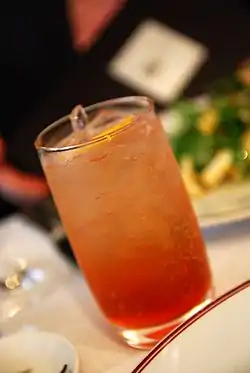 Lemon, lime and bitters is commonly consumed in Australia and New Zealand.
Lemon, lime and bitters is commonly consumed in Australia and New Zealand. The new Seven Color Tea, a recent competitor for national drink of Bangladesh.
The new Seven Color Tea, a recent competitor for national drink of Bangladesh. Indian Masala chai served in a red clay tea cup.
Indian Masala chai served in a red clay tea cup.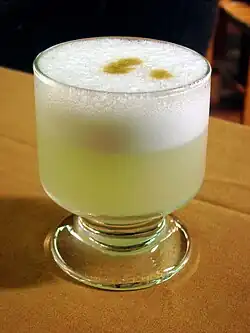
See also
References
- ↑ Caballero, B.; Finglas, P.; Toldra, F. (2015). Encyclopedia of Food and Health. Elsevier Science. pp. 345–351. ISBN 978-0-12-384953-3. Retrieved December 6, 2017.
- ↑ "United Nations Regional Groups of Member States". Department for General Assembly and Conference Management. United Nations. n.d. Retrieved 5 March 2019.
- ↑ Graveland, Bill (2009-05-14). "We stand on guard – for our favourite cocktail". Winnipeg Free Press. Retrieved 2019-06-27.
- ↑ The History of America's "National Drink", George Washington Inn 25 April 2018. Accessed on 23 February 2021.
- ↑ "The Evolution of an American Icon". CNBC. 9 November 2009.
- ↑ "The Week: The Latest News, Opinion, Sport, People & Business". The Week.
- ↑ Woodman, Stephen (23 March 2018). "Mexico's Senate Just Declared a New National Tequila Day". Culture Trip. Retrieved 2019-06-28.
- ↑ "Vino argentino". Retrieved 1 May 2023.
- ↑ Nalewicki, Jennifer (March 15, 2019). "The Story Behind Bermuda's Rum Swizzle (Recipe)". Smithsonian. Retrieved 11 June 2019.
- ↑ Jordan, Christina (October 25, 2017). "Cheers! Here's how to swizzle the national cocktail of Bermuda". Florida Today. Retrieved 11 June 2019.
The Rum Swizzle is probably the most well known swizzled cocktail. It's the national drink of Bermuda and uses Bermuda Rum.
- 1 2 3 4 5 Willett, Megan. "The Most Iconic Beverage In 80 Countries Around The World". Business Insider. Retrieved 2019-05-20.
- 1 2 3 4 5 "32 Official(ish) Drinks for Every Country Playing in the World Cup". Food & Wine. Retrieved 2019-05-20.
- 1 2 3 4 5 Rose, Jeremy (2018-06-14). "The Signature Drink of Every Country in the World Cup Gallery". The Daily Meal. Retrieved 2019-05-20.
- ↑ "Genuine Curaçao Liqueur and Premium Blue Curaçao | Senior Curaçao Liqueur". www.curacaoliqueur.com. Retrieved 2019-07-01.
- ↑ "Webpage about Curacao Liqueur and Triple secs". Archived from the original on May 29, 2013. Retrieved 2012-01-01.
- ↑ "In Haiti, a rum everyone can agree on". Los Angeles Times. 2010-02-09. ISSN 0458-3035. Retrieved 2019-07-03.
- ↑ "Bulgarian Archaeologists Discover 11th Century Rakia Distillation Vessel – Novinite.com – Sofia News Agency". www.novinite.com. Retrieved 2019-06-16.
- ↑ Mersom, Daryl. "The Cold War-era drink that rivals cola". www.bbc.com. Retrieved 2022-12-07.
- ↑ "6 national drinks that will make you a little squiffy". 22 March 2013.
- ↑ Joakim Persson (November 6, 2016). "Finnish Hartwall Original Long Drink now in Hong Kong". ScandAsia. Retrieved August 21, 2020.
- 1 2 3 "32 Official(ish) Drinks for Every Country Playing in the World Cup". Food & Wine. Retrieved 2019-05-19.
- 1 2 3 Rose, Jeremy (2018-06-14). "The Signature Drink of Every Country in the World Cup Gallery". The Daily Meal. Retrieved 2019-05-19.
- ↑ Cheung, Tim (2017-07-12). "World's 50 most delicious drinks". CNN Travel. Retrieved 2019-05-20.
- ↑ Sloat, Christopher Alessi and Sarah. "Germans Love Spezi, the 'Swamp Juice' Soda. Will Anyone Else?". WSJ. Retrieved 2022-12-07.
- ↑ Willett, Megan. "The Most Iconic Beverage In 80 Countries Around The World". Business Insider. Retrieved 2019-05-19.
- ↑ GUINNESS®. "Famous Brewer Expands with National Launch of GUINNESS® Black Lager". www.prnewswire.com. Retrieved 2019-05-19.
- ↑ "Why Guinness is less Irish than you think". The Economist. 2014-03-16. ISSN 0013-0613. Retrieved 2019-05-19.
- ↑ Katy Spratte Joyce (2020). "The Global Sip: Riga Black Balsam: Latvia's funky, herby liqueur". Chilled. Retrieved January 22, 2021.
- ↑ Rix, Juliet (3 December 2015). Malta and Gozo. Bradt Travel Guides. ISBN 9781784770259.
- ↑ "History of vodka production, at the official page of Polish Spirit Industry Association (KRPS), 2007" (in Polish). Archived from the original on 30 September 2007.
- ↑ "Porto wine – Made in Portugal". Portugal.com. 3 February 2018. Retrieved 2019-06-21.
- ↑ Schiessl, Courtney. "Portuguese Wines For Every Palate". Forbes. Retrieved 2019-06-21.
- ↑ Stein, Max (December 6, 2012). "Tuica – Romania's White Lightning". The Drinks Business.
- ↑ Ermochkine, Nicholas and Iglikowski, Peter (2003). 40 degrees east: an anatomy of vodka, Nova Publishers, p. 65, ISBN 1-59033-594-5.
- ↑ "Populär punch". www.aperitifklubben.se. Retrieved 2019-12-26.
- ↑ Abel, Ernest L. (2001-09-01). "The Gin Epidemic: Much Ado About What?". Alcohol and Alcoholism. 36 (5): 401–405. doi:10.1093/alcalc/36.5.401. ISSN 0735-0414. PMID 11524305.
- ↑ "The Scotch Whisky Regulations 2009". www.legislation.gov.uk. Retrieved 2019-06-12.
- ↑ Brooks, Libby (2007-05-30). "Scotland's other national drink". The Guardian. ISSN 0261-3077. Retrieved 2019-06-12.
- ↑ "3 Most Popular Welsh Alcoholic Beverages". www.tasteatlas.com. Retrieved 2021-03-04.
- ↑ "Eritrea - Cuisine".
- 1 2 "59 national drinks from 59 awesome countries". Matador Network. Retrieved 2019-05-20.
- ↑ Alexander, Kevin (2014-03-15). "World booze guide: The best things to drink in 43 countries". Thrillist. Retrieved 2019-05-20.
- ↑ Urban, Shilo. "The Art of Moroccan Mint Tea and How to Brew It". Organic Authority. Retrieved 2019-07-31.
- ↑ "How to Make the Perfect Pot of Moroccan Mint Tea". The Spruce Eats. Retrieved 2019-07-31.
- ↑ Agab, Muna Ahmed (1 April 1985). "Fermented food products 'Hulu Mur' drink made from Sorghum bicolor". Food Microbiology. 2 (2): 147–155. doi:10.1016/S0740-0020(85)80007-1.
- ↑ Studer, Nina (27 February 2019). "In 1930s Tunisia, French Doctors Feared a 'Tea Craze' Would Destroy Society". Atlas Obscura. Retrieved 11 June 2019.
- ↑ "What to Drink in Tanzania: The Most Popular Tanzanian Drinks". 25 January 2020.
- ↑ "Tea". Encarta. Archived from the original on 2008-03-08. Retrieved 2008-07-23.
- ↑ "Tea". The Columbia Encyclopedia Sixth Edition. 2001–07. Retrieved 2008-07-23.
- ↑ Zheng, Xiao‐Wei, et al. "Daqu—A traditional Chinese liquor fermentation starter." Journal of the Institute of Brewing 117.1 (2011): 82–90.
- ↑ Rong and Fa, Grandiose Survey of Chinese Alcoholic Drinks and Beverages, 2013, "Grandiose Survey of Chinese Alcoholic Drinks and Beverages". Archived from the original on 2014-07-29. Retrieved 2015-05-29.
- ↑ Hui, Sylvia (March 5, 2006). "'Pantyhose Tea' Has Leg Up in Hong Kong". The LA Times. Retrieved August 28, 2020.
- ↑ Lao-Phillips, Jenny (June 22, 2017). "MADE IN MACAO: COFFEE, TEA OR BOTH?". Macau Daily Times. Retrieved August 28, 2020.
- ↑ Kita, Satoye (January 12, 2009). "OCHA: JAPAN'S NATIONAL DRINK". The Bulletin. Retrieved August 27, 2020.
- ↑ "Airag – Fermented Mare's Milk – Mongolian Beverage".
- ↑ Zeder, Melinda A. ed. (2006). Documenting Domestication: New Genetic and Archaeological Paradigms. University of California Press. p. 264. ISBN 0-520-24638-1.
{{cite book}}:|author=has generic name (help) - ↑ Anderson, Eugene N. (1988). The Food of China. New Haven: Yale University Press. p. 80. ISBN 0300047398.
- ↑ Steinkraus, Keith H. ed (1995). Handbook of Indigenous Fermented Foods. Marcel Dekker. p. 304. ISBN 0-8247-9352-8.
{{cite book}}:|author=has generic name (help) - ↑ Indra, Rinchingiin (2003). "Mongolian Dairy Products". In Dendev Badarch, Raymond A Zilinskas (ed.). Mongolia Today: Science, Culture, Environment and Development. Routledge. p. 74. ISBN 0-7007-1598-3.
- ↑ Indra p. 73.
- ↑ Shim, Elizabeth (2019-06-18). "Pyongyang Soju selected national beverage of North Korea". UPI. ISSN 0261-3077. Retrieved 2019-07-30.
- ↑ Miller, Norman (2013-12-02). "Soju: the most popular booze in the world". The Guardian. ISSN 0261-3077. Retrieved 2019-05-20.
- ↑ "soju". Oxford Dictionary of English. Oxford University Press. Archived from the original on January 13, 2017. Retrieved 14 April 2017.
- ↑ "soju". Merriam-Webster Dictionary. Encyclopædia Britannica. Retrieved 22 November 2014.
- ↑ Miller, Norman (2 December 2013). "Soju: the most popular booze in the world". The Guardian. Retrieved 13 April 2017.
- ↑ Park, Eun-jee (19 November 2014). "Koreans looking for weaker soju". Korea JoongAng Daily. Retrieved 14 April 2017.
- ↑ Hall, Joshua (17 October 2014). "Soju Makers Aim to Turn Fire Water Into Liquid Gold". The Wall Street Journal. Retrieved 24 December 2014.
- ↑ Archibald, Anna (27 August 2015). "Why You Should Be Drinking Korean Soju Right Now". Liquor.com. Retrieved 14 December 2015.
- ↑ Jones, Edward (2018-11-13). "Who invented bubble tea? – Taipei Times". Taipei Times. Retrieved 11 June 2019.
Surprisingly little is known for sure about the origin of Taiwan's national drink
- ↑ Tai, Gloria. "Bubble Tea". China Live. Retrieved 11 June 2019.
It can almost be considered a national drink in Taiwan where it originated and took by storm in the 1980's
- ↑ Martin, Laura C. (2007). Tea: The drink that changed the world. Rutland: Tuttle Publishing. p. 219. ISBN 9780804837248.
- ↑ Rice, Jessica (22 August 2013). "59 national drinks from 59 awesome countries". Matador Network. Retrieved 28 July 2017.
- ↑ Grant, Lara (29 August 2016). "6 Local Liquors Around the World You Haven't Heard Of". Oyster.com. Retrieved 28 July 2017.
- ↑ Es teler
- ↑ Pat Tanumihardja (May 27, 2018). "Indonesia's delicious twist on avocados". The Week. Retrieved August 21, 2020.
- ↑ Sally Everett (12 April 2016). Food and Drink Tourism: Principles and Practice. SAGE Publications. p. 301. ISBN 978-1-4739-6597-3.
- ↑ "The cheapest alcohol in the world: Lao-Lao, Laos rice whiskey". www.priceoftravel.com. 9 December 2010. Retrieved 17 July 2017.
- ↑ "Disputes – International". CIA. Archived from the original on June 13, 2007. Retrieved 4 January 2011.
- ↑ "Lipton urges Malaysians to take pride in teh tarik, our national beverage". New Sabah Times. 7 September 2012. Archived from the original on 2 July 2014. Retrieved 6 November 2013.
- ↑ Gora, Sasha (2015-03-27). "Taking the Machismo and MSG Out of Myanmar's Tea Shops". Vice. Retrieved 2019-10-20.
- ↑ Crane, Brent (2019-10-20). "The Underage Tea Boys of Myanmar". Vice. Archived from the original on 2019-10-20. Retrieved 2019-10-20.
- ↑ Tiu, Cheryl (July 9, 2014). "Revolution and rum: 18 drinks inspired by the Philippines". CNN. Retrieved August 21, 2020.
- ↑ "Traditional Breakfast of Kaya and Kopi". www.roots.sg. Retrieved 2020-05-19.
- ↑ Aljunied, Khairudin (2014). "Coffee-shops in Colonial Singapore: Domains of Contentious Publics". History Workshop Journal. 77: 65–85. doi:10.1093/hwj/dbt011. S2CID 154985319 – via Oxford Academic.
- ↑ Max Falkowitz (August 7, 2012). "Snapshots from Singapore: A Guide to Singaporean Coffee". Seriouseats.com. Retrieved August 21, 2020.
- 1 2 Denise Chia (2014). "Milo Dinosaur: Uniquely Singapore". The Smart Local. Retrieved 29 November 2020.
- ↑ Pakiam, Geoffrey K. "Milo Dinosaur. The life and times of a Southeast Asian national beverage | IIAS". www.iias.asia. Retrieved 29 October 2021.
Milo Dinosaur's name appears to have originated in Singapore-based Indian-Muslim eateries during the mid-1990s. Labelling a turbo-charged version of ice Milo as Milo Dinosaur may have been a way to riff on Singapore's cinema culture, which during the 1990s was saturated with the exploits of giant reptiles in Jurassic Park and its sequels.
- ↑ Commins, Terry. "History of Tea in Thailand".
- ↑ Bangladesh Tea Research Institute, Banglapedia
- ↑ "সিলেটের সাতরঙা চা এর রহস্য ভেদ, জানুন তৈরির নিয়ম" (in Bengali). The Daily Prothom Alo. Archived from the original on May 4, 2017. Retrieved November 4, 2017.
- 1 2 "Making rainbows in a glass – seven-layer tea in Bangladesh". The Guardian. 28 August 2016. Retrieved November 2, 2017.
- ↑ Shay, Christopher (7 June 2011). "One Glass, Seven Layers of Tea – Scene Asia". Wall Street Journal. Wall Street Journal Blog. Retrieved November 7, 2017.
- ↑ "Merak and Sakteng – The Land of Brokpas". Wind Horse Tours online. Archived from the original on 2011-09-27. Retrieved 2011-07-27.
- ↑ "Lassi | beverage". Encyclopedia Britannica. Retrieved 2019-06-15.
- ↑ "5 Best Lassi Recipes: The Ultimate Summer Cooler from Punjab". NDTV Food. Retrieved 2019-06-15.
- ↑ Perry, Sara (August 2001). The New Tea Book: A Guide to Black, Green, Herbal and Chai Teas. Chronicle Books. ISBN 9780811830539.
- ↑ Harish, Chef (2014-08-22). "Make fantastic filter kaapi". The Hindu. ISSN 0971-751X. Retrieved 2019-06-15.
- ↑ Ethnic Fermented Foods and Alcoholic Beverages of Asia, Front Cover By Jyoti Prakash Tamang, Springer, 5 Aug 2016 – Technology & Engineering – 409 pages, P.107
- ↑ "Nepal: Liquor". The Global Gourmet. Archived from the original on 9 March 2016.
- ↑ P.67 Land and Social Change in East Nepal: A Study of Hindu-Tribal Relations By Professor Lionel Caplan, Lionel Caplan
- ↑ p.34 Kinship and Marriage Among the Limbu of Eastern Nepal: A Study By Rex Lee Jones – 1973
- ↑ "Sugarcane juice declared 'national drink' of Pakistan after Twitter poll". Hindustan Times. January 25, 2019. Retrieved August 21, 2020.
- ↑ Bakirova, Elita (2015-06-22). "Kyrgyzstan's fermented drink: a strong, salty national treasure". The Guardian. ISSN 0261-3077. Retrieved 2020-01-14.
- ↑ Nadworny, Katie (6 June 2019). "15 Things to Eat and Drink in Turkey". Fodors Travel Guide. Retrieved 11 June 2019.
Turkey's national drink isn't just a beverage—it's an experience. A clear anise liquor that turns milky white with water and ice (sometimes referred to as "lion's milk")
- ↑ Arditi, Talya (29 December 2015). "How to drink raki, Turkey's signature drink". CNN Travel. Retrieved 11 June 2019.
Meet raki – otherwise known as Lion's Milk – the Turkish national drink made of twice-distilled grapes and aniseed.
- ↑ Burch, Jonathon (27 April 2013). "Turkey's leader hits a nerve over country's "national drink"". Reuters. Retrieved 11 June 2019.
That is what Turkey's often divisive prime minister did late on Friday when he pronounced that the national drink was not beer, nor the aniseed spirit raki – choice tipple of Turkey's founding father – but the non-alcoholic yoghurt drink ayran.
- ↑ Kanan, Onur (May 22, 2014). "Ayran, Turkey's favorite summer drink". Daily Sabah. Retrieved 11 June 2019.
Ayran, which is also known as the non-alcoholic national drink of Turkey, is made of yogurt, water and salt.
- 1 2 3 Kriewaldt, Kit (8 December 2018). "We drink more than 100 million a year and it's all ours". ABC News. Retrieved 8 December 2018.
- ↑ Imperor, Rex (2013-12-02). "Toddy: The national drink of Kiribati". Imperor, All about the monarchy. ISSN 0261-3077. Archived from the original on 2019-07-30. Retrieved 2019-07-30.
- ↑ Confirel: Sugar Palm Tree – Conservation of natural heritage retrieved on 15 April 2012




.jpg.webp)
